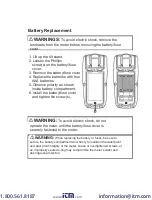
tested and calibrated and, with proper use, will provide many years
of reliable service.
WARNINGS
• Read, understand and follow Safety Rules and Operating
Instructions in this manual before using this meter.
• The meter’s safety features may not protect the user if not
used in accordance with the manufacturer’s instructions.
• Ensure that the test leads are fully seated in the input jacks
and keep fingers away from the metal probe tips when taking
measurements.
• Before changing functions using the selector switch, always
disconnect the test leads from the circuit under test.
• Use only UL listed test leads with the proper safety category rating.
• Comply with all applicable safety codes. Use approved
personal protective equipment when working near live
electrical circuits - particularly with regard to arc-flash
potential.
• Use caution on live circuits. Voltages above 30 V AC rms, 42 V
AC peak, or 60 V DC pose a shock hazard.
• Do not use if the meter or test leads if appear to be damaged.
• Verify operation before using meter by measuring a known live
voltage.
• Do not use the meter in wet or damp environments or during
electrical storms.
• Do not use the meter near explosive vapors, dust or gasses.
• Do not use the meter if it operates incorrectly. Protection
may be compromised.
• Do not operate meter while Low Battery warning is on.
Replace batteries immediately.
• Do not apply voltage or current that exceeds the meter’s
maximum rated input limits.
• When replacing the battery or fuses, be sure to secure the
battery compartment door firmly to maintain the waterproof and
dust proof integrity of the meter. Loose or overtightened screws,
or an improperly seated O-ring may compromise the meter's
water and dust ingress protection.
www.
.com
1.800.561.8187



































